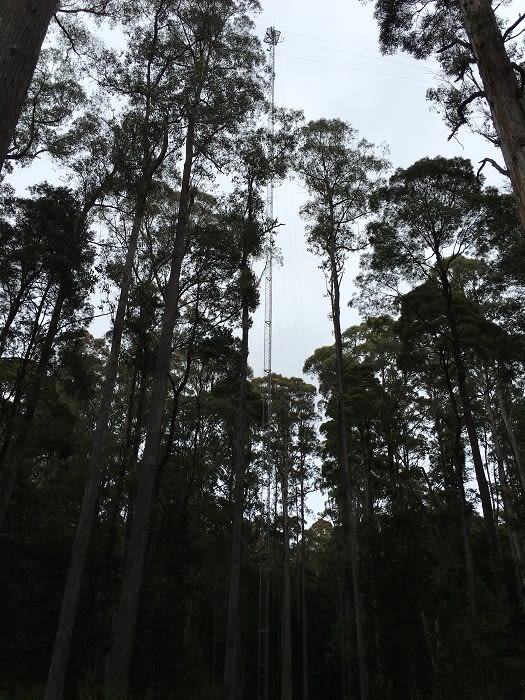Oz Flux 2015, Hobart, Tasmania
David Hammond, Ed Swiatek and Ivan Bogoev from Campbell Scientific recently attended the 2015 Oz Flux Conference held at the CSIRO Marine and Atmospheric Research facility in Hobart, Tasmania. The conference was hosted by Forestry Tasmania who manage the Oz Flux Warra tower, located in the Warra Long-Term Ecological Research area in southern Tasmania.

The Warra Flux tower contains a full suite of meteorological instruments including a Campbell Scientific CPEC200 Closed-Path Eddy Covariance system to measure CO2, water and energy fluxes. The 80m Warra tower is currently the highest installed CPEC200 measurement system anywhere in the world, and contains a 3-valve module which provides the capability to automatically measure and set the gas analyser zero and span using zero and span gas tanks located on site. The gas tanks, along with the main CPEC200 system enclosure, are housed in a 3 x 3.5m steel container located at the base of the tower, where the site operator has full access to all the measured data stored on the CR3000 datalogger. Currently there is no external communication from the CPEC200 system due to a lack of NextG reception at the site, but a future plan exists to install a radio link from the top of the flux tower to the nearby Blue Hill communication tower, from where data can then be transferred automatically to Forestry Tasmania’s computer network in Hobart.
The conference itself was spread over two weeks. Ivan Bogoev attended the Oz Flux Data Processing Workshop during the first week, where he had the opportunity to show attendees our patented IRGASON co-located Open-Path CO2/H2O/Sonic sensor, and our Closed-Path EC155 gas analyser supplied with the CPEC200 system. The second week of the conference comprised two days of scientific presentations based on current research from the Oz Flux tower sites around Australia and New Zealand. Ivan Bogoev from Campbell Scientific Inc., Logan, Utah, presented a paper entitled “Instrument-induced biases in open-path CO2 flux measurements”, which detailed the collaborative research undertaken between Campbell Scientific Inc. and the University of Montreal to reduce the differences in measured fluxes between Open-Path and Closed-Path systems by using high frequency sonic derived air temperature measurements to correct for the absorption line broadening effects of Open-Path CO2 flux measurements.
Introducing EasyFluxTM-DL

Oz Flux 2015 also provided an opportunity for Campbell Scientific Australia to launch our new EasyFluxTM-DL program for our Open-Path Eddy Covariance systems. EasyFluxTM-DL enables CR3000 and CR6 dataloggers to report fully-corrected fluxes of CO2, latent heat (H2O), sensible heat and momentum from a Campbell Scientific Open-Path Eddy Covariance system. Final fluxes are processed in the datalogger from raw time-series (10Hz) data by applying commonly used corrections found in scientific literature. This negates the need for post-processing software, allowing fully corrected fluxes to be reported at the end of each Eddy Covariance averaging interval.
For further information on EasyFluxTM-DL and our range of Eddy Covariance measurement systems, please contact Campbell Scientific Australia either by Phone (+61 (0)7 4401 7700) or Email (info@campbellsci.com.au).
We're now on Facebook!
Stay informed with our latest updates by following Campbell Scientific Australia.


